3.2 Exercise 2: Symmetry with passive negative space
xtine burrough and Michael Mandiberg
In this exercise, the black circle in the center of the composition is the positive space and the white surrounding area is the negative space. The negative space is not active, it is dictated by the active positive form. The circle is evenly distributed within the composition. It is perfectly symmetric in relation to both the x and y axes, from the left to the right and the top to the bottom.
- Open Adobe® Illustrator®. Create a new document in Illustrator® (File > New) using the default settings pull-down menu to create a letter size page in RGB color space.Name your document ‘lastname-firstname-symmetry’. When defining a new file, several settings must be taken into consideration. When you choose a new print document (as opposed, say, a new video document), Illustrator® loads some of the default settings — file resolution, document sizes, and so on — appropriate to that particular type of file. In the New Document dialog box, choose Letter from the Size pull-down menu. Letter (8.5 by 11 inches) is a common document size for print media. When we chose a new print document, the Size pull-down menu loaded standard sizes for the medium. If we selected a Web profile, the Size pull-down menu would have loaded standard settings for web design. For this exercise we will use 1 artboard and change our Units of measure to Inches. Click OK.
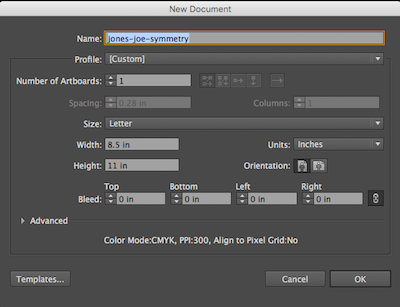
Creating a new document in Adobe® Illustrator® Now, save your document. Menu bar > File > Save. You do not need to change any of the default settings. The default file format is Adobe Illustrator (ai). This is the ‘native’ or original file. Later you will save the file as a PDF (Portable Document Format).
- Click on the rectangular shape tool (shortcut key M) to create one square that has a white fill and a black stroke. Set the fill and stroke colors before drawing the rectangle. The fill and stroke icons are stacked on top of each other at the bottom of the Tool Palette (see chapters 1 and 3 for working with the fill and stroke). Double-click the icon that is on top and select the color you want to use from the Color Picker. Once you set the color for the top icon (fill or stroke), click once on the bottom icon (if you took care of fill first, now you will set the color for the stroke) and define this color by using the Color Palette (Window > Color Palette).
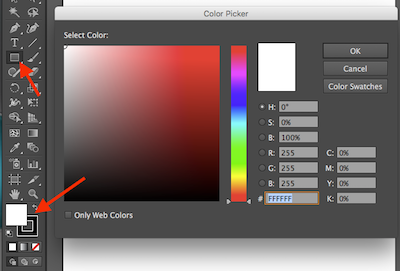
Location of the Rectangular Shape tool and Color Picker - With the white fill and black stroke colors defined, hold the shift key while dragging the Rectangle Tool on the Artboard. The result is a square instead of a rectangle. Click with the mouse and begin dragging before holding the shift key (SHIFT) and release the mouse before letting go of SHIFT. The square we made was about 2.5 X 2.5 inches.To size the square first select it, then go to the Control Panel > Transform and set the W (width) and H (height) at 2.5 (inches).
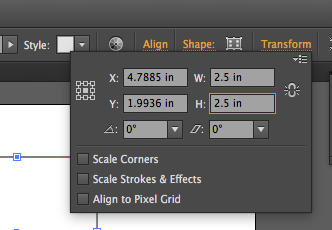
Example of how to size the square by using the Control Panel > Transform functions - While copy and paste are accessible through the Edit menu, we will use the Selection Tool to duplicate and position five copies of the square.
Hot Key: While you are working, CMD (command) is the hot key for the Select Tool.
Choose the Selection Tool and hold the option key (OPT) and click on the original square, then drag the mouse to the right. In Adobe® Creative Cloud®, Smart Guides are active by default. Smart Guides help to easily align and center objects with other objects and also the artboard. Hold the shift key to keep the movements restricted to a 0, 45, 90, or 180 degree motion (in other words, you’ll position the new square along the same baseline or x-axis to the right of the original square)
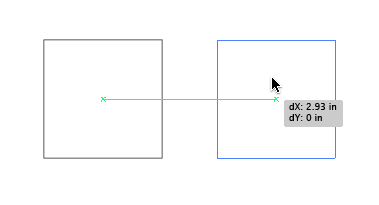
Duplicating and moving a square on a horizontal axis. Hot Key: The relationship between SHFT and the Select Tool is two-fold: 1. Shift will constrain the proportions of objects as you drag to resize a shape or image, and 2. Shift keeps the movement of objects aligned vertically or horizontally on the Artboard. - Now that you have two squares that are exactly the same, side by side, select both squares at one time by marqueeing over them (using your Selection Tool click and drag over both of them beginning on the artboard) or by selecting the first square and then holding shift while clicking with the mouse to add the second square to the selection. Group the two squares using (Menu bar) Object > Group.
- Grouped objects can be moved, transformed, and have their colors edited as one unit while their individual properties are maintained. In this case, the squares will be copied and positioned together.
- Copy the two squares two more times, moving down the page.
- Use the Select Tool to position the squares into place. Be attentive to the space between the margins of the page and the space between the outlines of the squares.
- Use the Layer Palette (Window > Layers) to lock the squares on Layer 1. Next to the eyeball at the left of Layer 1, click on the square illustrated below. A lock icon will appear, indicating that the layer is locked. Locked layers cannot be modified until they are unlocked. This is a protective measure that a designer often takes when part of a project is complete and she doesn’t want to accidentally select or move objects that are already established.
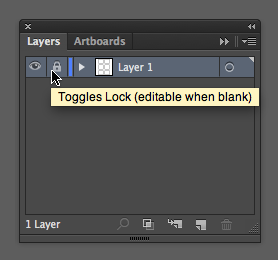
Location of the Toggle Lock on the Layers panel. - Once the layer is locked, create a new layer to work on by clicking the “Create New Layer” icon at the bottom of the Layer Palette. Layer 2 will appear above Layer 1. This is the layer that will contain the rest of the vector art objects in this chapter. Be sure that it is active (it will be highlighted) before proceeding.

Creating a new layer from the Layers panel - Create a black circle in the middle of the top left square with the Ellipse Tool. The Ellipse Tool might be buried beneath the Rectangle Tool in the Tool Palette, access it by holding a mouse click for a couple of seconds on the Rectangle Tool. All of the Shape Tools will be visible. Move the mouse over the Ellipse Tool to select it. With this tool, click and drag within the top left square. Hold the shift key once you begin dragging the mouse so that the ellipse becomes a perfect circle. Remember to change the color fill to black.
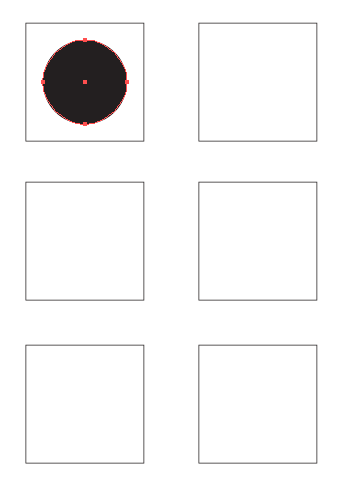
Positioning of your black circle is in the top right square. Be sure to save your files frequently!

